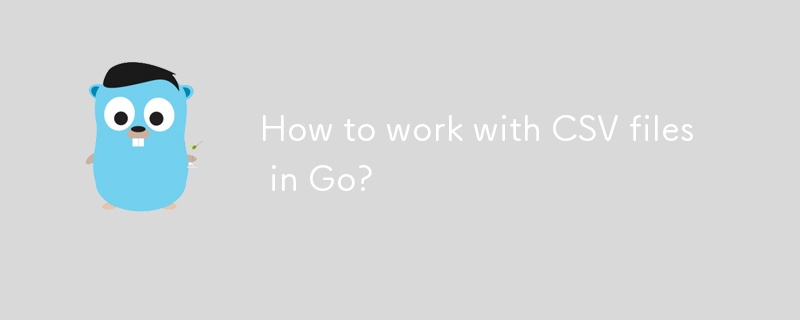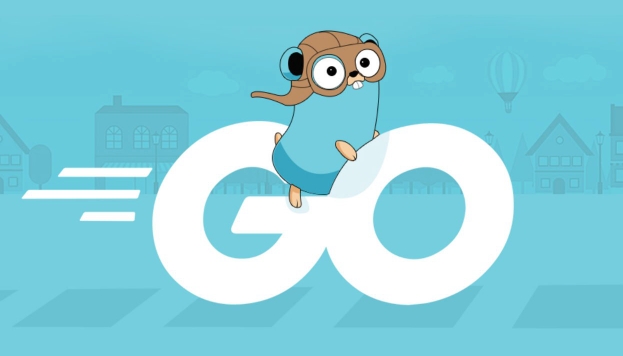Go language processes CSV files directly and efficiently, and the standard library encoding/csv can meet most needs. When reading, use csv.NewReader() to create a reader, and read data through ReadAll() or line by line; if the title line is included, you can skip the first line and set TrimLeadingSpace to remove spaces or Comma to replace the separator. When writing, use csv.NewWriter() to create a writer, call Write()/WriteAll() to output data. Note that the os.O_APPEND flag is required to add content and be sure to call Flush() to ensure that the data is landed. When dealing with special characters, the CSV package supports the RFC 4180 specification by default. Commas and newlines in fields need to be wrapped in quotes, and double quotes need to be escaped. When constructing CSV, unescaped special symbols should be avoided to ensure the correct format.

Processing CSV files is actually quite straightforward in Go language. encoding/csv package in the standard library can already meet most common needs. Whether it is reading or writing CSV data, it can be done easily with this package.

How to read a CSV file?
Reading CSV is one of the most common operations, such as exporting data from a database or parsing a table file uploaded by a user.
Go's csv.NewReader() method can help you create a reader and then get the data through .ReadAll() or line-by-line reading.

Let's give a simple example:
file, err := os.Open("data.csv")
if err != nil {
log.Fatal(err)
}
defer file.Close()
reader := csv.NewReader(file)
records, err := reader.ReadAll()
if err != nil {
log.Fatal(err)
} The above code will read the entire CSV file into the two-dimensional string slice of records at one time. Each row is an array of strings corresponding to a column of data.

Tips:
- If your CSV file has a header, you can skip the first line after reading it.
- You can set
reader.Comma = '\t'to read the TSV file. - Use
reader.TrimLeadingSpace = trueto automatically remove spaces before the field.
How to write to a CSV file?
Writing to CSV is just as simple as creating a writer using csv.NewWriter() and then calling .Write() or .WriteAll() methods.
For example, generate a CSV file with several records:
file, _ := os.Create("output.csv")
writer := csv.NewWriter(file)
defer writer.Flush()
headers := []string{"Name", "Age", "City"}
data := [][]string{
{"Alice", "30", "New York"},
{"Bob", "25", "San Francisco"},
}
writer.Write(headers)
for _, record := range data {
writer.Write(record)
}This will generate a CSV file with header and two rows of data.
Note:
- Remember to call
.Flush()after writing the data, otherwise the data may not be written in. - If you want to append content instead of overwriting, you can use
os.OpenFileand add theos.O_APPENDflag.
How to deal with special characters or formats in CSV?
CSV looks simple, but what you actually encounter may not be that clean. For example, if there are commas, line breaks or quotes in the field, the default parsing method may be incorrect at this time.
Go's CSV package supports RFC 4180 format by default, that is:
- The commas in the field are correctly recognized as delimiters;
- When a newline appears in a field, the field should be wrapped in double quotes;
- Double quotes themselves need to be escaped, i.e. two consecutive double quotes represent one.
So as long as your input is based on this specification, there will generally be no problem.
If you construct CSV data yourself, it is also recommended to avoid unescaped commas or newlines in the fields. If it is really impossible to avoid it, be sure to wrap the field in double quotes and escape the internal quotes.
Basically that's it. Go handles CSVs very practical and does not require additional dependence on third-party libraries. As long as you master ReadAll , Write and some format precautions, you can deal with most scenarios.
The above is the detailed content of How to work with CSV files in Go?. For more information, please follow other related articles on the PHP Chinese website!

Hot AI Tools

Undress AI Tool
Undress images for free

Undresser.AI Undress
AI-powered app for creating realistic nude photos

AI Clothes Remover
Online AI tool for removing clothes from photos.

Clothoff.io
AI clothes remover

Video Face Swap
Swap faces in any video effortlessly with our completely free AI face swap tool!

Hot Article

Hot Tools

Notepad++7.3.1
Easy-to-use and free code editor

SublimeText3 Chinese version
Chinese version, very easy to use

Zend Studio 13.0.1
Powerful PHP integrated development environment

Dreamweaver CS6
Visual web development tools

SublimeText3 Mac version
God-level code editing software (SublimeText3)

Hot Topics
 Strategies for Integrating Golang Services with Existing Python Infrastructure
Jul 02, 2025 pm 04:39 PM
Strategies for Integrating Golang Services with Existing Python Infrastructure
Jul 02, 2025 pm 04:39 PM
TointegrateGolangserviceswithexistingPythoninfrastructure,useRESTAPIsorgRPCforinter-servicecommunication,allowingGoandPythonappstointeractseamlesslythroughstandardizedprotocols.1.UseRESTAPIs(viaframeworkslikeGininGoandFlaskinPython)orgRPC(withProtoco
 Understanding the Performance Differences Between Golang and Python for Web APIs
Jul 03, 2025 am 02:40 AM
Understanding the Performance Differences Between Golang and Python for Web APIs
Jul 03, 2025 am 02:40 AM
Golangofferssuperiorperformance,nativeconcurrencyviagoroutines,andefficientresourceusage,makingitidealforhigh-traffic,low-latencyAPIs;2.Python,whileslowerduetointerpretationandtheGIL,provideseasierdevelopment,arichecosystem,andisbettersuitedforI/O-bo
 Is golang frontend or backend
Jul 08, 2025 am 01:44 AM
Is golang frontend or backend
Jul 08, 2025 am 01:44 AM
Golang is mainly used for back-end development, but it can also play an indirect role in the front-end field. Its design goals focus on high-performance, concurrent processing and system-level programming, and are suitable for building back-end applications such as API servers, microservices, distributed systems, database operations and CLI tools. Although Golang is not the mainstream language for web front-end, it can be compiled into JavaScript through GopherJS, run on WebAssembly through TinyGo, or generate HTML pages with a template engine to participate in front-end development. However, modern front-end development still needs to rely on JavaScript/TypeScript and its ecosystem. Therefore, Golang is more suitable for the technology stack selection with high-performance backend as the core.
 How to install Go
Jul 09, 2025 am 02:37 AM
How to install Go
Jul 09, 2025 am 02:37 AM
The key to installing Go is to select the correct version, configure environment variables, and verify the installation. 1. Go to the official website to download the installation package of the corresponding system. Windows uses .msi files, macOS uses .pkg files, Linux uses .tar.gz files and unzip them to /usr/local directory; 2. Configure environment variables, edit ~/.bashrc or ~/.zshrc in Linux/macOS to add PATH and GOPATH, and Windows set PATH to Go in the system properties; 3. Use the government command to verify the installation, and run the test program hello.go to confirm that the compilation and execution are normal. PATH settings and loops throughout the process
 Resource Consumption (CPU/Memory) Benchmarks for Typical Golang vs Python Web Services
Jul 03, 2025 am 02:38 AM
Resource Consumption (CPU/Memory) Benchmarks for Typical Golang vs Python Web Services
Jul 03, 2025 am 02:38 AM
Golang usually consumes less CPU and memory than Python when building web services. 1. Golang's goroutine model is efficient in scheduling, has strong concurrent request processing capabilities, and has lower CPU usage; 2. Go is compiled into native code, does not rely on virtual machines during runtime, and has smaller memory usage; 3. Python has greater CPU and memory overhead in concurrent scenarios due to GIL and interpretation execution mechanism; 4. Although Python has high development efficiency and rich ecosystem, it consumes a high resource, which is suitable for scenarios with low concurrency requirements.
 How to build a GraphQL API in golang
Jul 08, 2025 am 01:03 AM
How to build a GraphQL API in golang
Jul 08, 2025 am 01:03 AM
To build a GraphQLAPI in Go, it is recommended to use the gqlgen library to improve development efficiency. 1. First select the appropriate library, such as gqlgen, which supports automatic code generation based on schema; 2. Then define GraphQLschema, describe the API structure and query portal, such as defining Post types and query methods; 3. Then initialize the project and generate basic code to implement business logic in resolver; 4. Finally, connect GraphQLhandler to HTTPserver and test the API through the built-in Playground. Notes include field naming specifications, error handling, performance optimization and security settings to ensure project maintenance
 Choosing a Microservice Framework: KitEx/GoMicro vs Python Flask/FastAPI Approaches
Jul 02, 2025 pm 03:33 PM
Choosing a Microservice Framework: KitEx/GoMicro vs Python Flask/FastAPI Approaches
Jul 02, 2025 pm 03:33 PM
The choice of microservice framework should be determined based on project requirements, team technology stack and performance expectations. 1. Given the high performance requirements, KitEx or GoMicro of Go is given priority, especially KitEx is suitable for complex service governance and large-scale systems; 2. FastAPI or Flask of Python is more flexible in rapid development and iteration scenarios, suitable for small teams and MVP projects; 3. The team's skill stack directly affects the selection cost, and if there is already Go accumulation, it will continue to be more efficient. The Python team's rash conversion to Go may affect efficiency; 4. The Go framework is more mature in the service governance ecosystem, suitable for medium and large systems that need to connect with advanced functions in the future; 5. A hybrid architecture can be adopted according to the module, without having to stick to a single language or framework.
 Go sync.WaitGroup example
Jul 09, 2025 am 01:48 AM
Go sync.WaitGroup example
Jul 09, 2025 am 01:48 AM
sync.WaitGroup is used to wait for a group of goroutines to complete the task. Its core is to work together through three methods: Add, Done, and Wait. 1.Add(n) Set the number of goroutines to wait; 2.Done() is called at the end of each goroutine, and the count is reduced by one; 3.Wait() blocks the main coroutine until all tasks are completed. When using it, please note: Add should be called outside the goroutine, avoid duplicate Wait, and be sure to ensure that Don is called. It is recommended to use it with defer. It is common in concurrent crawling of web pages, batch data processing and other scenarios, and can effectively control the concurrency process.






